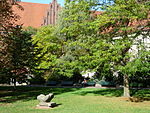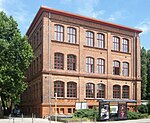Märkisches Museum
Buildings and structures in MitteCity museumsHistory museums in GermanyMuseums in Berlin

The Märkisches Museum (Marcher Museum; originally Märkisches Provinzial-Museum, i.e. Museum of the Province of the March [of Brandenburg]) is a museum in Mitte, Berlin. Founded in 1874 as the museum of the city of Berlin and its political region, the March of Brandenburg, it occupies a building on the northern edge of Köllnischer Park, facing the Spree, which was designed by Ludwig Hoffmann and completed in 1908. It is now the main facility of the Stiftung Stadtmuseum Berlin, Landesmuseum für Kultur und Geschichte Berlins, the City of Berlin museum foundation, which also operates four other sites.
Excerpt from the Wikipedia article Märkisches Museum (License: CC BY-SA 3.0, Authors, Images).Märkisches Museum
Am Köllnischen Park, Berlin Mitte
Geographical coordinates (GPS) Address External links Nearby Places Show on map
Geographical coordinates (GPS)
| Latitude | Longitude |
|---|---|
| N 52.513611111111 ° | E 13.414722222222 ° |
Address
Märkisches Museum (Stadtmuseum)
Am Köllnischen Park 5
10179 Berlin, Mitte
Germany
Open on Google Maps










